How GNSS Augmentation Impacts Business Aircraft Operators

Global Navigation Satellite System (GNSS) augmentation comes in different forms but has the same objective: to improve the GNSS system’s attributes and allow aircraft operators to take advantage of lower approach minimums. As it’s not always clear what augmentation system(s) and performance capabilities an operator has, it’s important to verify your particular GNSS augmentation status and capabilities. Here’s what you should know:
1. What GNSS augmentation is
GNSS augmentation is a method of improving the navigation system’s attributes – such as accuracy, reliability and availability – through integration of external information into the calculation process. There are many such systems in place, and they’re generally described based on how GNSS sensors receive the external information.
2. Types of augmentation that are available
Satellite-Based Augmentation Systems (SBASs), Ground-Based Augmentation Systems (GBASs) and Aircraft-Based Augmentation Systems (ABASs) are the three main types of augmentation available to aviation users. Most aircraft will have some form of ABAS, while many newer intercontinental business jets have all three augmentation systems.
3. What satellite constellations are available for GNSS
GPS (US), GLONASS (Russia) and Galileo (Europe) satellite constellations are currently available to aviation operators for navigation and approach purposes. China and India will have GNSS systems in the future. SBASs, GBASs and ABASs are used to augment one or more of the above satellite systems. Wide-Area Augmentation Systems (WAASs), Local-Area Augmentation Systems (LAASs) and European Geostationary Navigation Overlay Services (EGNOSs) are specific augmentation systems designed, implemented and operated by various countries/entities.
4. How GNSS augmentation affects operators
Augmentation systems allow operators to fly to lower approach minimums. GNSS augmentation improves accuracy of GPS satellite navigation system by compensating for GPS discrepancies via transmission of corrections to GPS receivers – either via satellite or terrestrial radio. This improves satellite position accuracy and can pinpoint location within a range of less than three feet (one meter) in some cases.
5. What SBAS is
SBAS provides operators with accuracy of 7.6 meters (25 feet) or better (lateral and vertical) 95% of the time. It supports WAAS and regional augmentation through use of additional satellite broadcast messages. This augmentation allows operators to fly to lower minimums on RNAV (GPS) and RNAV (RNP) approaches.
6. How various SBASs differ
SBAS is currently in use in North America, with WAAS operated by the Federal Aviation Administration (FAA); in Europe with EGNOS; and in Japan with the Multi-Functional Satellite Augmentation System (MSAS) operated by Japan’s Ministry of Land, Infrastructure and Transport. Many other parts of the world – including India, Russia and China – have proposed implementing systems, but those proposals are still in process.
7. How GBAS works
GBAS supports augmentation through use of terrestrial radio messages. Ground stations take measurements concerning GNSS and transmit that information directly to the end user. This allows operators to take advantage of lower minimums. The US uses an LAAS for GBAS. This is an all-weather landing system based on differential correction of GPS signals in real time. Correction data is transmitted to users via VHF data link, to correct GPS signals, and provides a standard instrument landing system (ILS)-style display to use while flying a precision approach.
8. What ABAS is
ABAS is achieved by features of onboard equipment designed to overcome performance limitations of GNSS constellations. As this is aircraft-based equipment – to augment GNSS receivers – it is not country-specific and can be used aboard any aircraft regardless of where in the world it is. The two systems currently in use are Receiver Autonomous Integrity Monitoring (RAIM) and Aircraft Autonomous Integrity Monitor (AAIM). RAIM algorithms perform consistency checks on position and require a sufficient number of satellites in view, along with a favorable geometric arrangement of those satellites. Another method is “Baro-aiding,” which uses the pressure altitude, corrected for the local barometric pressure setting, to provide accurate altitude information to the GNSS receiver.
9. How GNSS augmentation impacts new format flight plans
In the recently-introduced 2012 Flight Plan (FPL) format, the International Civil Aviation Organization (ICAO) suggests indicating any GNSS augmentation in Item 18, Navigation sub-field (NAV/), but that is not required. You’ll use various descriptors in the FPL to identify not only equipment capabilities but also that it is serviceable and that the flight crew meet minimum requirements to operate the aircraft with specified equipment and/or capabilities. This requires operators to keep 3rd-party providers advised on changes to precision navigation capability so that air traffic control (ATC) has the correct data.
Closing thoughts
Be mindful of the various GNSS augmentation systems that are a part of your GNSS software and approach minimums that these systems may allow you to operate. It’s recommended that operators review aircraft equipment, operational specifications and aircraft/crew capabilities to take advantage of existing GNSS augmentation capability. Be sure to keep 3rd-party providers updated on changes to onboard equipment and capabilities of the aircraft.
Questions?
If you have any questions about this article or about GNSS augmentation, contact me at jasondavidson@univ-wea.com.




